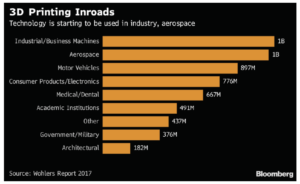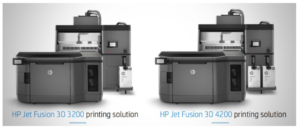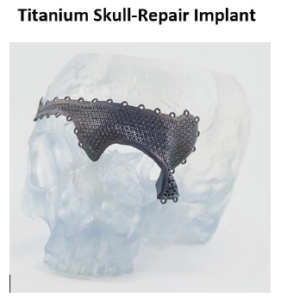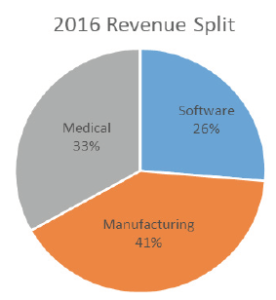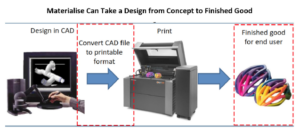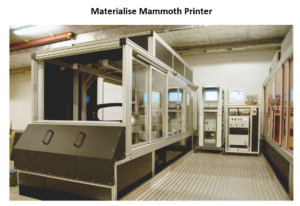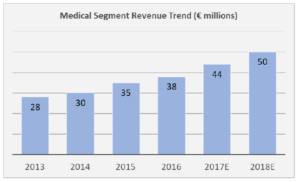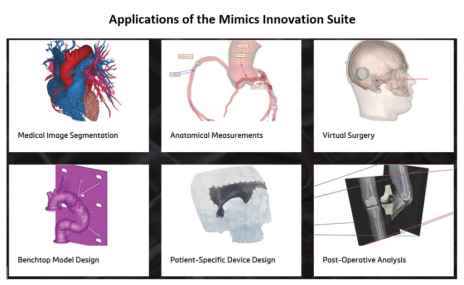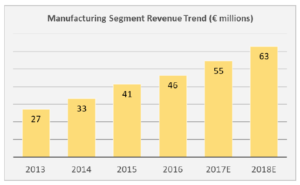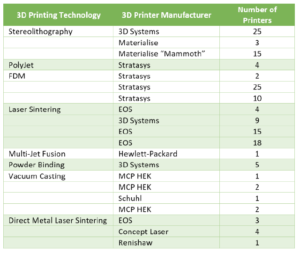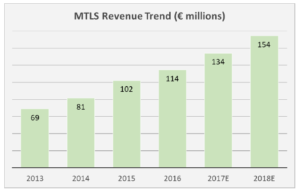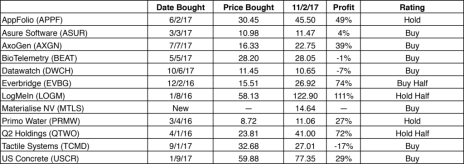Today’s addition to our portfolio is different from the rest in a number of ways. It’s not a pure-play cloud software stock, though it has a software division that generates 26% of revenue. It’s not a pure-play medical device stock, though it has a medical division that generates 33% of revenue. It’s not even based in the U.S.!
Cabot Small Cap Confidential 222
[premium_html_toc post_id="141017"]
THE BIG IDEA
Remember when 3D printing stocks were all the rage?
Investors couldn’t buy them fast enough. And the technology was widely discussed as the having the potential to turn every garage in North America into a high-tech repair shop.
Then things just seemed to fall apart. The honeymoon came to an end, and the once-hot stocks melted down.
But it wasn’t that the potential for 3D printing technologies evaporated!
It’s that everyone in the industry was going their own way, doing their own thing, and trying to close out potential competitors. It didn’t work. The industry was at such an early stage that customers weren’t ready to commit the time and capital to just one 3D printing technology, software or manufacturer. They needed to keep their options open.
It also became clear that consumer-oriented 3D printing wasn’t the industry’s real growth engine; it was industrial manufacturing. That probably contributed to declining investor enthusiasm since investors didn’t really want to talk about how many more bolts and nuts can be printed in a week, and at what cost, compared to other manufacturing methods.
But now, industrial stocks are coming back into favor. And based on industry reports, the 3D printing industry is growing very fast. Wohlers Associates sees the industry quadrupling within the next six years, to $26 billion. As this chart shows, industrial, aerospace, and auto applications are leading the charge.
The 3D printing industry has also evolved. It’s now focused more on collaborations and partnerships. This strategy of pooled resources hasn’t made the industry totally friendly (reports I’ve read make it sound quite cutthroat, in fact), but it does appear to have separated some of the potential winners and losers. Most of the 3D printing stock being touted years ago are in the loser camp for the time being.
Of the big industrial companies, two leaders are emerging: General Electric (GE) and Siemens.
In recent years, GE has purchased several 3D printing specialists. It bought Morris Technologies in 2012, which uses laser sintering technology to print metal parts for jet engines. Then GE purchased Arcam and made a failed takeover offer for SLM Solutions in September 2016. Both companies specialize in 3D printing metal. A month later, GE purchased a 75% share in Concept Laser, which also specializes in metal 3D printing technology.
For its part, Siemens reached a deal with EOS Electro Optical Systems, a large manufacturer of 3D printers, to automate every EOS machine with Siemens technology.
Then there’s Hewlett-Packard (HPQ). The printing powerhouse officially announced its entry in the 3D printing market in October 2014 when it unveiled its Multi Jet Fusion technology. Multi Jet Fusion is reportedly 10-times faster and much stronger than anything currently on the market. It has 30,000 printer nozzles spraying 350 million drops per second of powdered material as it moves back and forth across the printing platform. It combines binder jet printing (liquid bonding agent) with selective laser/electron beam sintering (heat fusing) to make an extremely strong product.
That announcement coincided with the decline in shares of many companies that manufactured 3D printers, and in the months since, many have struggled to revamp their business models to better fit industry dynamics. HP’s printers just hit the market last quarter.
If you’re excited about the potential of 3D printing but have watched most of these stocks decline, what do you do? How to you align yourself with the big boys?
You can buy shares of HP, which is probably a good move. But it’s not a small cap.
Or you can buy shares of the one small-cap 3D printing stock I like! This company has grown revenue at an average annual rate of 18% over the last four years. And it doesn’t make 3D printers.
While this is an industrial company, it still has a very exciting story and is involved in cutting-edge projects. Its technology was recently used to 3D print a new shoulder for a woman shot in a hunting accident, to 3D print custom insoles that helped power an Ironman athlete to victory, and to 3D print a near-perfect model of King Tutankhamun’s remains.
Its diverse offerings are a plus in my book. It doesn’t compete with HP, GE and Siemens. Instead, the company has aligned itself with many of the biggest businesses in the industry by developing open-source 3D printing software. It also makes 3D printed medical devices and is a manufacturer of outsourced 3D printed production parts and prototypes.
In other words, it has aligned itself to participate in industry-wide growth, not just one area. And it looks like revenue growth of 15% to 20% should continue and EPS growth should accelerate. That’s why it’s this month’s Cabot Small-Cap Confidential candidate.
THE COMPANY/PRODUCT
Materialise (MTLS) is a Belgium-based company specializing in 3D printing software, 3D printed medical devices and on-demand 3D printing services for the industrial, medical and consumer industries. It does not manufacture 3D printers, other than one large-format proprietary model used purely for in-house printing. Its biggest end-markets are medical (especially orthopedic), industrial (especially automotive), aerospace, consumer and art & design. The company has a market cap of $713 million.
Materialise software is used by customers in all industries to enhance the functionality and efficiency of their 3D printing operations. Industry-specific software solutions are also used to help doctors plan virtual surgeries, convert medical images to 3D models, and design custom 3D-printed implants. On-demand 3D printing services are used by customers who wish to outsource manufacturing of custom-made medical implants, industrial prototypes and production parts, and consumer products.
The company’s business model is heavily focused on collaborations and partnerships, and as such it has penetrated virtually all areas of the 3D printing industry. Several of these collaborations have resulted in consumer-oriented services, such as 3D-printed custom eyeglasses, foot beds and ski boot inserts, as well as a consumer, academic and inventor-focused business that allows people to upload their 3D design for Materialise to print.
The company has been in the market for 27 years, and over that time, has grown its software suite and printing services into one of the largest offerings in the industry. It has over 200 patents and another 180 pending. As a Belgium-based business (with ADR shares listed on the Nasdaq), the company offers investors an opportunity to participate in a small-cap industrial growth story with exposure to Europe (59% of revenue), the Americas (27% of revenue) and Asia (14% of revenue).
Materialise has a relatively diversified sales mix, organized into three divisions: 3D Printing Software (26% of revenue), Medical Software and 3D-Printed Products (33% of revenue) and Manufacturing (41% of revenue).
Revenue growth isn’t off-the-charts fast, but it’s very solid for an industrial company. And the stock appears undervalued relative to its growth. Sales grew by 12.2% in 2016 (to €114.5 million), and should grow in the 15% to 20% range in both 2017 and 2018.
While management is being conservative with forward guidance, it appears the business is accelerating given that 3D printing is increasingly capable of producing more complex and durable parts, the method is gaining market share for manufactured end-parts, and demand is growing for patient-specific medical devices.
Materialise is working to capitalize on the trends by growing its manufacturing services, gaining regulatory approval for more 3D-printed objects for the medical and aerospace industries, and striking software partnerships with major industrial companies, including Siemens and Hewlett-Packard.
A key part of the Materialise story is that the company is software-open-source and hardware-agnostic, meaning it is compatible with almost all 3D printers on the market. This gives customers a neutral and flexible platform upon which they can build the applications that work best for them. By offering the freedom to use the printer(s) of its clients’ choosing, Materialise has become one of the industry’s most relied-upon companies. And it hasn’t pigeonholed itself into one area of this evolving industry.
A Crash Course in 3D Printing
What is 3D Printing?
Technically known as additive manufacturing (AM), 3D printing is the process of laying down successive layers of material to build objects of almost any shape. Industrial 3D printers use a variety of materials to “print” objects. Plastics are the most common material used, although metals are being increasingly used as printer jets and software become more sophisticated. The technology has moved beyond prototyping, hobbyist use and small-scale manufacturing to become more common in full-scale production lines. It is reshaping manufacturing processes around the world, evidenced by its extensive use in the aerospace (some jet engines are 3D printed!), medical (almost all hearing aids are 3D printed) and automotive industries.
Where Does Materialise Fit in?
The company’s customers typically fall into one (or more) of three categories. First, there are customers who 3D print objects in-house. They are most concerned with optimizing print files, preparing build platforms and controlling the printing process—they use Materialise software. Then there are customers who subcontract their 3D printing (usually prototypes or end-use parts)—they rely on Materialise to engineer and print their designs. The third group consists of customers that are introducing 3D printing into their businesses (usually healthcare companies and industrial customers)—they typically work with Materialise software and production facilities to cover everything from design to production.
Here’s an example. Let’s say a customer wants to build bike helmets. Its engineers use computer-aided design (CAD) software to create a 3D helmet design. Materialise software helps them take that CAD design, slice it into cross-sections, determine what type of support structure is needed, then send the order of assembly to the best-matched 3D printer on the Materialise production floor (it has over 160 to choose from!). That printer builds the helmet layer by layer (or cross section by cross section), using the desired materials and specifications from the CAD file.
How is this Diversity a Competitive Advantage?
Because it plays in three end-markets (software, medical and manufacturing), Materialise is constantly getting customer and internal production team feedback that becomes part of its deep knowledge base and fuels innovation in all three competencies. For example, the company uses the best 3D printers and materials on the market, regardless of manufacturer, to print surgical guides and custom implants that have been approved by both U.S. and European regulators. That know-how can be applied to other markets such as automotive and aerospace, where precision and longevity are critical attributes of end parts.
The company has 165 3D printers and six vacuum casting machines at its service centers in Belgium, the Czech Republic, Germany, Poland, Japan and the U.S. Available 3D printing technologies include stereolithography, laser sintering, FDM, PolyJet, powder binding, Multi Jet Fusion, selective laser melting (SLM) and vacuum casting.
Included in its printer count are 15 large, proprietary 3D printers, capable of printing items up to two meters long. This big machine design is called “Mammoth” and is based on a technology known as stereolithography. In very basic terms, this technology works by passing a laser over a resin tank, and the areas touched by the laser are solidified. Layer by layer, the desired object is printed, then raised out of the resin tank and finished with manual smoothing, painting, etc.
Let’s talk about each of Materialise’s three segments.
Materialise Software
3D printing software is an indispensable part of the design and printing process, and is typically used to optimize print files, insert support structures and organize both the printing process and shipping to the end-consumer.
Software accounts for 26% of company revenue, and grew by 43% and 17% in 2015 and 2016, respectively. Customers are active in the automotive, aerospace, consumer goods, medical and external 3D printing service bureau markets. The customer base is well-diversified, with the 10 largest customers accounting for less than 16% of segment revenue in 2016.
Materialise software is compatible with almost all types of 3D printers, and numerous software applications and capturing technologies (including CAD and 3D scanners). This allows customers with large operations and many machines from multiple manufacturers, including 3D Systems, Stratasys, ExOne, SLM Solutions, Arcam, Concept Laser, Envision, Renishaw and Voxeljet, to rely on Materialise software and still use their machine of choice.
Magics
Magics is the company’s flagship solution, and is has become the “backbone of the 3D printing industry,” according to the Materialise management team. It connects any CAD application to any 3D printer, and allows users to import, repair and optimize design files (including CAD and standard tessellation language (STL) files) before printing. Typical activities include designing support structures, documenting customer projects, nesting multiple parts in a single print run, and planning the printing process.
The company sells different suites of Magics software depending on the use case. For instance, the professionals suite is for service bureaus, the manufacturing suite is for OEMs that operate 3D printing lines, and partner versions are for 3D printer manufacturers (such as Hewlett-Packard) who integrate the platform into their product offering.
Streamics
Streamics was added as an up-sell product to Magics a few years ago to help 3D printing operations handle the growing volume of production. The product functions like a mission control system, linking an operator’s various 3D printers, processes, materials and shipment flows in one integrated and user-friendly system. Functionality includes part analysis, platform prep and scheduling, reporting, central data storage collaboration and machine capacity planning tools.
Build Processor
Materialise Build Processor is the technology that bridges the gap between 3D printers and software. It’s like the print driver for your desktop printer, and allows all print management tools to communicate with a given 3D printer. Users can tweak printer preferences to finely control the printer and do things like slice models into layers data, ensure objects have adequate support and texture, etc. Materialize has forged partnerships with several AM machine manufacturers to provide a custom version of Build Processor for their machines, including Arcam, EOS, Renishaw, SLM, Concept Laser, 3D Systems and Hewlett-Packard.
Additional Solutions
Materialise offers a host of other software solutions that perform various functions. For instance, Robot streamlines and speeds up the 3D printing process by reducing human interaction, E-Stage helps reduce material use so customers spend less time sanding and finishing printed parts, and Machine Control translates 3D model data into sliced geometry that’s easily interpreted by 3D printers. The table below gives a sense of where each solution fits in the planning, formatting, product design and 3D printing process.
Given that Materialise software is open-source, sales growth is closely tied to the growth of additive manufacturing and the number of industrial 3D printing operations. The company emphasizes OEM collaborations, which currently make up 30% of Software segment sales, and have the potential to push this segment higher as new partnerships kick in (more on this in a minute!). It also sees metal-based printing as one of key areas of opportunity. That reasoning factored into its October 4, 2017 acquisition of ACTech, a full-service manufacturer of complex cast metal parts. Working with ACTech’s production team should help Materialise develop its metal-specific 3D printing software solutions.
Materialise Medical
Medical is the company’s second largest division at 33% of sales, and is broken into two areas: software and clinical services. Segment revenue was up 16.1% and 8.8% in 2015 and 2016, respectively. But don’t let the relatively modest growth fool you; 3D printing applications for healthcare represent massive opportunities, especially in the areas of joints and surgical guides.
Implantable devices can be designed from a patient’s medical image and printed on a variety of manufacturer printers using Materialise software. Compared to custom devices made of metal or plastic from subtractive manufacturing methods, 3D printed parts are typically of better quality, have fewer design and structural limitations, and usually can incorporate greater complexity without additional cost. Which would you rather have in your body?
Mimics Innovation Suite
Medical software makes up 37% of the segment’s revenue, and the Mimics Innovation Suite is the main medical software package. Customers use Mimics either as (1) an R&D tool to develop new medical devices (cutting-edge capabilities are important), (2) an R&D tool to help innovate surgical approaches (evolving capabilities are valued) or (3) as a production tool for making custom medical devices (a stable product with regulatory approvals is most important). The segment has 24 dedicated 3D printers.
The company offers suites of complementary products to match each customer’s needs. For instance, Mimics segments 3D models from medical imaging data and exports the model for manufacturing. 3-Matic combines CAD tools with the anatomical data file imported from Mimics, allows customers to analyze and measure 3D models, design patient-specific implants, guides or benchtop models, and prepare the anatomical data/implants for simulation. OrthoView is a 2D digital pre-operative planning and templating solution for orthopedic surgeons. It imports a digital X-ray and positions templates of prostheses on the X-ray at the correct scale.
Clinical Services
Materialise uses its FDA-cleared and CE-compliant medical software to analyze 3D images of patients, then help their doctors plan for surgery. The company also designs and 3D prints surgical guides and/or implants for that specific patient. The biggest end-markets are for orthopedic guides and implants (mostly for knee, shoulder and hip replacements, as well as craniomaxillofacial (CMF) implants (for head, neck, face and jaws). Materialise also prints anatomical models that are used for sizing medical devices, clinical trials, training, patient communication and marketing. One example is its HeartPrint service, which provides 3D-printed cardiovascular anatomical models (heart, veins, etc.).
The customer base consists of academic institutions, medical device companies and hospitals. In 2016, the majority of 3D-printed devices were surgical guides and related bone models that were distributed to surgeons through collaborations with Zimmer-Biomet, DJO Surgical, DePuy Synthes, Stryker and others (most products are sold under the brand name of the collaborator). It also began selling patient-specific implants directly to hospitals and through DePuy Synthes’ TRUMATCH CMF Solutions in Australia, Europe and, in September, the U.S. (titanium implants for corrective jaw surgery).
Materialise Manufacturing
The Manufacturing segment is a service bureau, meaning it operates shops full of 3D printers to make prototypes and production parts for customers. This segment generated 41% of revenue in 2016, and grew by 25% and 12% in 2015 and 2016, respectively. It has 120 dedicated 3D printers and six vacuum casting machines.
Additive Manufacturing Services (80% of segment revenue)
This consists of rapid prototyping (60% of Additive Manufacturing service revenue) and parts production for the automotive, aerospace, consumer goods, industrial goods, art and architecture industries.
Niche Industrial & Consumer Solutions (20% of segment revenue)
RapidFit+ provides the automotive market with customized, precise and/or patent-protected measurement and fixturing tools. The service lets auto manufacturers and suppliers improve their efficiency and quality by making test products (like bumpers) before assembly.
i.materialise is a global online 3D printing service catering to ordinary consumers. Designers, students, inventors and anybody else that wants can just upload their 3D designs, select their desired materials and colors, and get immediate pricing. It is also possible to post designs on the i.materialise catalogue, which contains things like 3D printed lamps, furniture and other home furnishings, many of which were developed with well-known designers and are featured in museums (including the Museum of Modern Art in NY, and the Centre Pompidou in Paris). The company sees i.materialise as an early-stage bet on consumer-generated 3D printing opportunities.
Management says the Manufacturing segment is seeing increased demand for automotive, aerospace and consumer parts, as well as orthopedic implants, surgical guides, dental copings and hearing devices. There are also shoots of growth in specialty furniture, home and office accessories, fashion products, jewelry and footwear. Because of high demand, Materialise has expanded its production capabilities by adding a new 8,000-square-meter facility in Poland and expanded its Belgium facility by 9,000 square meters. It moved into both in October.
Key Partnerships
Siemens is a global industrial company generating over $80 billion in revenue in areas including automation, digitization, energy and healthcare. In early 2017, the company announced it would integrate Materialise Magics 3D Print technology into its product lifecycle management (PLM) software, Siemens NX, which is used to design everything from automobiles and aircraft to consumer products. The addition will help industrial clients by allowing them to work with one solution to both design and prepare 3D printing files. Materialise began recognizing revenue from this partnership in Q2, but management was clear to state that it isn’t yet a meaningful percentage of software sales.
Hewlett-Packard is a printing technology powerhouse. And the recent introduction of its Multi Jet Fusion 3D Printer is likely to change the entire manufacturing industry. HP says the machine is up to 10-times faster than competitors’ machines, and produces at half the cost. It also comes with HP Build Processor, a tailored 3D printing solution developed with Materialise that simplifies the 3D printing process. Sales of HP’s printer just launched mid-Q2 2017, so Materialise hasn’t benefited from this partnership yet. But you can be sure it’ll be discussed on next week’s Q3 earnings call! As with the Siemens partnership, this has the potential to be a meaningful collaboration.
HOYA Vision Care is part of a global medical technology company that’s been pushing optics innovations for over 50 years. It teamed up with Materialise to develop the Yuniku platform to make vision-centric 3D-printed eyewear. The system uses a special scanner to measure facial features, then software calibrates the best position for the lenses, taking into consideration lifestyle and frequency of use. Augmented reality software then allows people to see how they’ll look with the frames on.
Once approved, personalized lenses and frame are 3D printed by Materialise. Sales related to this partnership contributed to the Manufacturing segment’s Q2 2017 results.
The Business Model
Materialise Software derives revenue from software licenses (cloud-based, or on premise), maintenance contracts, hardware controller sales and custom software development. Roughly 80% of Materialise software sales come through the direct sales force, with sales through third-party distributors and OEMs (software packaged with a 3D printer) making up the rest. Materialise Medical derives revenue from software (37% of segment revenue) licenses and maintenance contracts, 3D printed medical devices and custom software development services. Medical devices are mostly distributed through collaboration partners and distributors. Software is sold through a direct sales force and through partners. Materialise Manufacturing derives revenue through the sale of 3D printed prototypes, production parts and consumer-submitted designs. The bulk of sales are generated by an internal sales force and specialized sales managers in Europe, with a smaller portion coming directly through the Materialise OnSite web portal.
The Bottom Line
Materialise has a four-year average revenue growth rate of 18%. Revenue growth was in the 16% to 25% range from 2013 to 2015. Last year (2016) was a relatively slow year as revenue was up only 12%. It has not been profitable since 2014, when it delivered EPS of -€0.05, but should be able to turn a small profit in 2017.
In Q2 2017 (reported in August), Materialise reported revenue growth of 22%, a 164% increase in adjusted EBITDA, and flat EPS growth (EPS was -€0.02). Manufacturing was the fastest growing segment, up 33%, while Software was up 19% and Medical was up 10%. Those results mean that through the first half of 2017, revenue is up almost 21% and EPS loss has been cut in half to -€0.04. Materialise ended Q2 with a strong balance sheet, including €54 million in cash and equivalents and €40 million in debt.
Management was cautiously optimistic on the call, saying each segment was outperforming expectations through the first half of the year, but it wasn’t going to lift guidance above its previously disclosed range. It appeared to build-in some conservatism given potential disruptions in the Manufacturing segment due to the large expansion in Poland and Belgium. Management expects the sales teams to have to “…fight for every inch of growth…”
It does see more customers turning from R&D to small batches of 3D printing for end parts production, and believes investments in manufacturing capacity, along with new collaborations (HP, Siemens, etc.) will spur growth and help diversify its revenue base. And it said that it currently has 165 printers in production, including two HP Multi-Jet fusion printers.
It seems conservative to estimate that Materialise should grow by around 17% in 2017 (to €134 million, the high end of management’s guidance), and by at least 15% in 2018. Additionally, with demand and margins expanding, EPS should turn positive this year (to around €0.02), then jump up to around €0.10 in 2018.
RISK
European Exposure: Materialise generates 59% of revenue in Europe, 27% in the Americas and 14% in Asia. As such, it is primarily a play on EU growth, with some U.S. exposure. That’s good now (the EU is growing), but might not always be the case. It also means the company is less well-known to U.S.-based investors.
Customer Concentration: Two years ago, the Medical segment’s device sales were heavily reliant on a partnership with Zimmer Biomet (roughly 70% of sales). Today, Materialise is less reliant on this partnership (40% of medical device sales). While that’s a positive, Zimmer Biomet still makes up a large percentage of sales.
Internal 3D Printing Operations: As customers grow, they might be tempted to take 3D printing services internally. This occurred with Zimmer Biomet when those two companies merged in 2014, and sales of medical guides fell as a result. While a more diverse customer base is good (i.e., DuPuy Synthes has ramped up), further consolidation of the customer base, especially in the Medical segment, could dent revenues.
Reliance on Collaborations: As an open-source software provider and a company active in all facets of the 3D printing industry, Materialise is very dependent on its many collaborations. I think this is a positive, but if industry factors drive companies toward more protectionist business models, Materialise might have to rethink its growth strategy.
Uncertain Pace of Industry Growth: As we’ve seen, this industry isn’t a sure bet in the short-term. While the long-term opportunities seem relatively clear, there’s no guarantee that Materialise will succeed as the industry evolves. Given that it often takes years for materials and devices to gain approval in many of the industry’s biggest markets (i.e., medical and aerospace), the pace of industry growth is very difficult to determine.
COMPETITION
Materialise Software competes indirectly with software developed by 3D printer OEMs, which is typically printer-specific. Primary competitors gravitating toward more open-source solutions are AM and machine control software providers, including Autodesk, Parametric Technology and Dassault. The Medical segment competes with companies that provide 3D printed surgical models and devices, including Medical Modeling, SimpleWare, 3mensio, Apollo and WITHIN Lab. The Manufacturing segment competes with companies providing industrial 3D printing services, including 3D Systems, Proto Labs, Cresilas and ARK. Additional competition comes from larger companies that move their 3D printing production in house, but in these scenarios, there are often opportunities for Materialise to provide software or manufacturing services to augment in-house production. The most prominent competitors to i.materialise are Shapeways and Sculpteo.
THE STOCK
Trading Volume: Materialise has a market cap of $713 million and trades an average of 60,000 shares daily. That means just under $1 million worth of stock trades each day. Our subscriber group shouldn’t move this stock. That said, trading volume is relatively thin. Heavy days are +100,000 shares, and that’s happened eight days over the last six months. As is our normal strategy, you should average in.
Historical Price: The stock began trading in the U.S. in mid-2014 at 12, and declined to around 6 by the beginning of 2016 as investor appetite for 3D printing stocks eased. Shares firmed up and traded mostly sideways through 2016, then began to gather momentum in early 2017. Earnings reports in early May and early August helped the stock form a pattern of higher highs and higher lows over the last six months, with pullbacks firming up just below the upward slowing 50-day line. The most recent jump came in early October, when MTLS spiked to a 52-week high of 16.5. Over the last month, it has pulled back, and has traded in the 14.5 to 15.75 range for the past three weeks.
Valuation and Projected Price Target: I’m expecting Materialise to grow revenue at around its average four-year pace (let’s say 16% to 19%) for the next couple of years. Provided margins expand (as expected), the company should enjoy rapid EPS growth and command a higher valuation from the market. If we assume a target EV/Sales multiple of 5.5 based on 2018 estimated revenue, we arrive at a 20 price target. That implies roughly 25% upside from here. That’s a good, conservative starting point that can be revised if EU growth continues to accelerate, industrial companies continue to command higher premiums, and management provides forward guidance exceeding mine.
Buy Range (next two months): My wide preferred buy range is between 12.5 and 16.5. That takes us down to the support zone from mid-August and up to the 52-week high from early October. A narrower range of 14.5 (where the 50-day line is) to 16 is the most reasonable buy range prior to the earnings report next week, after which I’ll update our buy range.
The Next Event: Management will announce Q3 2017 results at 6:30 a.m. ET on Thursday, November 9. The conference call will follow at 8:30 a.m. ET.
Materialise (MTLS) Financials
Materialise (MTLS 14.64) |
UPDATES ON CURRENT RECOMMENDATIONS
Due to the nature of the stocks recommended, it is to your advantage not to share these recommendations.
Strong Buy means the stock should be bought immediately and is expected to move sharply higher in the very near future.
Buy means accumulate shares at or around the current price.
Hold means just that; hold what you have. Don’t buy, or sell, shares.
Sell means the original reasons for buying the stock no longer apply, and I recommend exiting the position.
Sell a Half means it’s time to take partial profits. Sell half (or whatever portion feels right to you) to lock in a gain, and hold on to the rest until another ratings change is issued.
We have a lot to get to this week with a number of earnings updates, and a quick preview of many more for next week. I’m going to skip all the high-level talk, and just get right to our stocks today.
Updates
AppFolio (APPF) was moved to Hold last week after shares fell 8% to their 50-day line for the first time since May. The stock didn’t do much this week as investors are now in wait-and-see mode with earnings coming out on Monday. The only clue we have about how AppFolio might do are results from competitor RealPage (RP), who delivered results that were shy of expectations by a very, very slim margin. Full-year guidance remains slightly above analyst expectations, however (just over 17% revenue growth). One standout item from that company’s quarter was a $3.4 million impact on renters’ insurance revenue from hurricanes Harvey and Irma. It’s reasonable to expect some impact on AppFolio as well. We shouldn’t read too much into RealPage’s results since there are different factors at play in that business versus AppFolio’s, but at a high level there weren’t any major issues with its quarter and the stock was essentially unchanged after reporting. For AppFolio’s part, we’re looking for Q3 revenue growth of 29%, 2017 revenue growth guidance of 32%, and indications that revenue can grow by at least 26% in 2018. We also want Q3 EPS of at least $0.07, 2017 EPS of at least $0.31, and indications that 2018 EPS can exceed $0.43. The company has a history of beating expectations, so suffice to say it needs to do so again. If you’re aggressive, you can go ahead and try to play an earnings-induced rally, but there’s no guarantee! The more conservative move is to sit on your 50% gain through earnings, and take it from there. I’m keeping at Hold for now. HOLD.
Announced earnings date: Monday, November 6
Asure Software (ASUR) bounced back by 12% this week and is now back to its 50-day line. Management will report a week from Monday. I checked out competitor Paycom’s (PAYC) results from yesterday which, as usual, beat expectations. That said, management did say there was some negative impact from the hurricanes which dented new customer prospects. It’s likely we’ll hear something similar from Asure. Ultimate Software (ULTI) also reported and results came in better than expected, although expectations were pretty low. I think there’s potential for Paycom to pull back (it’s been rallying) and Ultimate Software to gain momentum (it’s been lagging) given some of the details in those companies’ respective reports. How does this potentially affect Asure? It’s unclear. It appears the broad market for HCM software is still strong, and Asure’s acquisition-led growth strategy means it’s growing far faster than competitors (estimated revenue growth in 2017 is 55%). But there is some integration/execution risk (though not much given most acquisitions are outfits currently using Asure’s software anyway). The bigger issue is that nobody knows about Asure. But that will change, if it executes. This morning’s jobs number was great with some make-up hiring following the hurricane season, and U.S. unemployment is now down to 4.1%. The market appears friendly for a company like Asure. Keeping at Buy. BUY.
Announced earnings date: Monday, November 13
AxoGen (AXGN) reported another solid quarter after the bell on Wednesday with revenue of $16.05 million beating by $460,000, and up 43%. EPS loss of $0.06 (a $0.02 improvement over Q3 2016) was as expected. Shares zoomed over 10% higher, most likely because management said revenue should grow by at least 40% in 2017 (it’s up 46% YTD) and 2018, while gross margins should be maintained above 80% in both years. That’s awesome.
Active accounts were up 36% to 563, the company has 53 direct sales reps (33 have been with it for 12 months or more), and 20 independent distribution partners. Given that revenue is up more than active accounts, it’s clear that sales rep productivity is going up (that’s good). AxoGen plans to hire at least seven more sales reps by the end of the year. Hurricanes had minimal impact in the quarter. Management also said new data from the RANGER study found that nerve repairs completed with Avance Nerve Graft continue to show meaningful recoveries, even in cases with longer gaps. This data is incredibly helpful for surgeons who are trying to understand nerve repair outcomes and, potentially, adopt solutions from AxoGen’s bag of goodies. There is no update on the Recon Phase 3 pivotal study, which compares Avance Nerve Graft to manufactured conduits for digital nerve injuries, other than that enrollment should be done in Q4 2018 (a year from now).
As hoped, surgeons are expanding use of AxoGen’s solutions in oral and maxillofacial procedures (such as mandible reconstructions due to benign tumor resection), as well as in hand nerve-repair procedures. The newest targeted markets are breast reconstruction neurotization (to provide sensation following mastectomy) and nerve injuries from lower limb total joint replacements (orthopedic surgeons need to cut nerves to complete these procedures). Management had no updates on these initiatives on the conference call, but said it will at the upcoming Analyst and Investor Day on November 20. On that note, management is going to be busy over the next two months with a number of appearances at conferences. I expect shares will continue to do well as the story gets out and new money is attracted to the growth. We’re up 39%, and the trend is strong. Be a little cautious after this jump, but continue to accumulate on the dips. Keeping at Buy. BUY.
Earnings: Done
BioTelemetry (BEAT) was down 5% this week for the second week in a row. Shares have just been demolished since that Off Wall Street short attack came out, even though analysts have picked up coverage and boosted price targets on the stock (both SunTrust and Raymond James initiated coverage of the heart monitoring specialist with price targets of 41 and 37, respectively, within the last two weeks). The three factors at play, aside from that short attack, are concerns that (1) upstart iRhythm (IRTC) will eat Biotelemetry’s lunch with its ZIO monitoring patch, (2) that integration of the acquired LifeWatch business will be bumpy for BioTelemetry, and (3) that storms in the last quarter will cause the company to miss expectations. I think there is something to the competitive threat from iRhythm, but the fact remains that BioTelemetry is the leader in remote cardiac monitoring, and is also coming out with its own patch. I don’t think customers will leave en masse to go with a less proven company. And I think there is plenty of room in this market for multiple winners. We’ll see. On the acquisition front, we don’t know how it’s going, but will get an update next week! And as far as the hurricanes go, I’ve scanned SEC filings for any mention of geographic exposure that could hurt (i.e., Puerto Rico), and came up with nothing. The bottom line appears to me that shares of BioTelemetry have been killed on the perception of threats, but not confirmation. The burden of proof remains on management, but provided it continues to execute its growth agenda, as I expect it will, shares should recover from this dip. Given the size of the pullback, there is potential for a huge post-earnings rally. I think the stock is a good buy here. BUY.
Announced earnings date: Tuesday, November 7
Datawatch (DWCH) was volatile after reporting earnings and closed down around 10% yesterday, putting us roughly 8% down from our entry point. The headline was an EPS miss (-$0.01 versus expectations of $0.01) and a revenue beat (revenue up 18.5% to $10.2 million beat by $710,000). Full-year results showed a 19% increase in revenue and an EPS improvement from a loss of $0.66 to a loss of $0.11. To me, these high-level results were good.
Management highlighted a couple of notable customer deals (expansions and/or new deals), including Sherwin Williams, T.J. Maxx, Sysco, Coca-Cola, Sun Life Financial and the Bank of New York Mellon. There were 2014 net new customers in the quarter, 14 more than in last year’s comparable quarter. There were 62 expand deals, 10 more than last year. The average deal size in the quarter of $47K was up $11K from last year.
Management also said that its real-time visualization solution, Panopticon, is the clear market leader for investment banks and financial services companies. Sales of Panopticon and Monarch Complete let growth (both up over 20%), as expected. There was some drag in the quarter from the retirement of a legacy product, and that solution won’t contribute any revenue in the year ahead. The company continued its measured approach to growing subscriptions sales, with subscription growth up 45% and representing 20% of the quarter’s license revenue. The company has $30.5 million in cash, so a secondary offering isn’t a big concern.
I think investors might be a little disappointed that management said the sales cycle for the new enterprise product, Monarch Swarm, would be a little longer than for other products. This isn’t surprising to me. It’s a new product, should carry a larger dollar value, and hasn’t been fully tested in the market yet. I don’t think we should count any of this against Datawatch at this point. Swarm represents a big potential growth opportunity, but also is the first real enterprise-level cloud-based product from Datawatch. Let’s give it a few quarters to see how it plays out. The company is putting together a special sales team to sell the product, and will hopefully announce some partnerships over the coming months to help get it out there.
The bottom line is that Datawatch is still a tiny company with a devoted user base for Panopticon and Monarch Complete that’s trying to expand its market, move to more of a cloud-based subscription model, and launch products (Swarm) that carry bigger price tags. This will take time, but based on this quarter’s results, I think it’s making progress. We saw shares sell off after the reports, which to be frank, isn’t out of line with what’s happened after earnings releases in 2017. In this case, I think there was some extra selling pressure since the stock fell through the 50-day line, and that likely triggered some limit sell orders. I think our investment thesis holds, shares will bounce back and resume their uptrend, and I’m keeping at Buy. BUY.
Earnings: Done
Everbridge (EVBG) is still moving sideways and will report earnings on Monday. The market is looking for revenue growth of 33%, to $26.4 million, and EPS of -$0.06. I think it will do better. The trend has been more big deals, with multiple products sold, and I see demand for critical communications solutions only going up. Are hurricanes, wind storms, terrorist attacks, etc. going to go away? This is an aggressive call, but I’m moving back to Buy. Shares have been consolidating for over a month now near a 52-week high, and I think big investors are just waiting for confirmation of a good quarter and bright outlook before digging in deeper. Don’t go in too heavy, but you can pick up a few shares ahead of earnings if you’re game. BUY A HALF.
Announced earnings date: Monday, November 6
LogMeIn (LOGM) spiked to almost 130 after reporting earnings last week then pulled back to the 122 to 124 range. I think the hook has been set and big investors will increase their positions in the stock. I’ve already seen a number of price target increases and estimates are going up. Keep holding. HOLD HALF.
Earnings: Done
Primo Water (PRMW) is still a Hold given the stock’s discouraging trend. I think there’s considerable potential for a pop in shares after earnings, but it’s just a little too dicey to double down on the stock right now. Keep holding. We’ll have an earnings report on Tuesday, and will take it from there. Consensus estimates call for $0.11 in EPS and 118% revenue growth, to $77.5 million. I want to hear about cash flow and debt reduction plans. HOLD.
Announced earnings date: Tuesday, November 7
Q2 Holdings (QTWO) reported a better-than-expected quarter with revenue of $50.1 million up 31% and beating by a slim margin ($70K), and EPS of $0.03 beating by $0.05 (a sizeable beat). Active users on the Q2 Platform went up 27% (400,000 new users) to nearly 10 million. Management also provided full-year 2017 guidance of 29% revenue growth (to $194 million), which is about as expected. Significant wins included an $8 billion Midwest bank that was running disparate systems for consumer and commercial customers, and a $5 billion bank in the Northeast that replaced its corporate banking suite with Q2’s.
In recent months, I’ve mentioned potential concerns that M&A activity in Q2’s market could dent growth. Management gave an update on this front, saying it expects to lose 13 logos, with five of them acquired by existing Q2 customers and eight lost to non-Q2 customers. The net result will mean customer count will decline slightly in 2017 from the 365 reported at the end of 2016. A few new customers have also begun phased go-live schedules, which will push some anticipated Q4 revenue into Q1 2018. The net result is that management reduced full-year guidance by about $600K. It also stepped back just a little from setting expectations of 25% revenue growth in 2018 to a range of 23% to 25%, saying that the year should be a little more back-end loaded.
M&A is a potential headwind. But, on the positive side, when you dig into the numbers, the bottom line is that customer churn is expected to stay at 5% or less. Over time. the trend is that smaller customers are lost to M&A and their revenue goes away relatively quickly (all customers are migrated off Q2’s platform at once). But Q2 is landing bigger customers, which takes longer to migrate customers onto the platform, but which are more likely to stay. So, net-net, Q2’s customer count might go down a little, but users on the platform should go up.
It’s also worth mentioning that Q2 just hired Christine Peterson as Chief Revenue Officer. She’s a seasoned exec from FIS, and helped grow that business from a few hundred million in revenue to almost $10 billion. Today, Q2 is generating around $200 million in annual revenue, but it’s building the business to generate $1 billion or more. Seasoned execs can help it get there. The bottom line is Q2 had a decent quarter but has tempered investor expectations a little. That could put pressure on shares over the next couple of months, especially if the broad market softens up. I’ll be keeping an eye on the stock’s performance since, at this point, that’s the best indicator of how the market feels about it. I’ll also review analyst upgrades/downgrades/price target changes over the next week and give you on update on those. For now, keep holding. HOLD HALF.
Earning: Done
Tactile Systems (TCMD) has been under pressure since it priced a secondary offering for an existing shareholder (non-dilutive) in early-September at 33 (roughly 10% below where the stock was at the time), after which a Seeking Alpha author wrote a bearish article, further pressuring the stock. The two big questions related to that article that management needs to address on next week’s earnings call are (1) whether or not a bigger trend in device rentals will develop, and (2) what the level of patent protection on new devices is (including the head and neck solution). Of course, the state of deals with VA hospitals is also important (it sounded very strong last quarter), as are reimbursement trends, profit margin trends, etc. Shares are now down around 17% from our entry. But, I’m not moving to Hold because I need something definitively negative first! Like our other beaten-down names, there’s potential for Tactile to pop on earnings if it can allay concerns. We’re looking for 22% revenue growth in Q3 with EPS of $0.04, as well as guidance for 27% revenue growth in 2017, and at least 20% in 2018. Keeping at Buy through earnings, then I’ll reevaluate. BUY.
Announced earnings date: Tuesday, November 7
U.S. Concrete (USCR) reported this morning and results fell short of expectations, largely due to the hurricanes (no surprise, heard the same story from other concrete companies). Revenue was up 7.9% to $355 million ($14 million shy of expectations) and EPS of $0.99 was down from $1.19 (and missed by $0.27). Ready-mixed concrete sales were up 8.6% (price per yard up 3%), and aggregate products revenue was down 5.3% (price per ton up 2.7%).
Management said the weather in Texas deferred around 200,000 cubic yards of concrete sales and 90,000 tons of aggregate. At an average price of $136.62 per yard (concrete) and $12.25 per ton (aggregate) that works out to roughly $28.4 million, which accounts for the revenue shortfall, and then some! It also accounts for some of the EPS miss, and it’s important to note that this revenue didn’t go away, it just gets pushed back. There was also a $1.9 million hurricane-related loss recorded for the U.S. Virgin Islands operation, as well as a $2.2 million charge for dredging at one quarry. In short, the weather was an issue, but won’t affect the long-term trajectory of the company. That’s why shares aren’t trading lower, despite the miss.
I missed the conference call since I was working on other projects, but will report back with more details once I get a chance to listen to the replay. Shares are steady today, I anticipate keeping at Buy. BUY.
Earnings: Done
Please email me at tyler@cabotwealth.com with any questions or comments about any of our stocks, or anything else on your mind.
Next Cabot Small-Cap Confidential issue is scheduled for December 1, 2017
Cabot Small-Cap Confidential is published by the Cabot Wealth Network, an independent publisher of investment advice. Neither the corporation nor its employees are compensated in any way by the companies whose stocks we recommend. Sources of information are believed to be reliable, but they are in no way guaranteed to be complete or without error. Recommendations, opinions or suggestions are given with the understanding that subscribers acting on information assume all risks involved. Copyright © 2017 - COPYING AND/OR ELECTRONIC TRANSMISSION OF THIS NEWSLETTER IS A VIOLATION OF THE U.S. COPYRIGHT LAW. For the protection of our subscribers, if copyright laws are violated by any subscriber, the subscription will be terminated.
[premium_html_footer]


